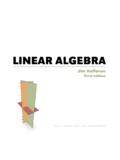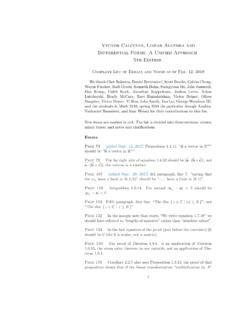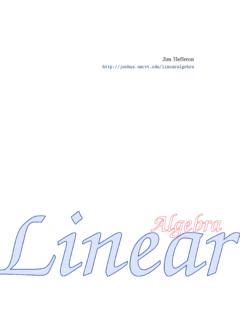Transcription of Linear Algebra - Joshua
1 Linear Algebra . Jim Hefferon Third edition Notation R, R+ , Rn real numbers, positive reals, n-tuples of reals N, C natural numbers {0, 1, 2, .. }, complex numbers (a .. b), [a .. b] open interval, closed interval h..i sequence (a list in which order matters). hi,j row i and column j entry of matrix H. V, W, U vector spaces ~v, ~0, ~0V vector, zero vector, zero vector of a space V. Pn , Mn m space of degree n polynomials, n m matrices [S] span of a set hB, Di, , ~ ~ basis, basis vectors En = h~e1 , .. , ~en i standard basis for Rn V= W isomorphic spaces M N direct sum of subspaces h, g homomorphisms ( Linear maps). t, s transformations ( Linear maps from a space to itself). RepB (~v), RepB,D (h) representation of a vector, a map Zn m or Z, In n or I zero matrix, identity matrix |T | determinant of the matrix R(h), N (h) range space, null space of the map R (h), N (h) generalized range space and null space Greek letters with pronounciation character name character name alpha AL-fuh nu NEW.
2 Beta BAY-tuh , xi KSIGH. , gamma GAM-muh o omicron OM-uh-CRON. , delta DEL-tuh , pi PIE. epsilon EP-suh-lon rho ROW. zeta ZAY-tuh , sigma SIG-muh eta AY-tuh tau TOW (as in cow). , theta THAY-tuh , upsilon OOP-suh-LON. iota eye-OH-tuh , phi FEE, or FI (as in hi). kappa KAP-uh chi KI (as in hi). , lambda LAM-duh , psi SIGH, or PSIGH. mu MEW , omega oh-MAY-guh Capitals shown are the ones that differ from Roman capitals. Preface This book helps students to master the material of a standard US undergraduate first course in Linear Algebra . The material is standard in that the subjects covered are Gaussian reduction, vector spaces, Linear maps, determinants, and eigenvalues and eigenvectors. Another standard is book's audience: sophomores or juniors, usually with a background of at least one semester of calculus. The help that it gives to students comes from taking a developmental approach this book's presentation emphasizes motivation and naturalness, using many examples.
3 The developmental approach is what most recommends this book so I will elaborate. Courses at the beginning of a mathematics program focus less on theory and more on calculating. Later courses ask for mathematical maturity: the ability to follow different types of arguments, a familiarity with the themes that underlie many mathematical investigations such as elementary set and function facts, and a capacity for some independent reading and thinking. Some programs have a separate course devoted to developing maturity but in any case a Linear Algebra course is an ideal spot to work on this transition. It comes early in a program so that progress made here pays off later but it also comes late enough so that the classroom contains only students who are serious about mathematics. The material is accessible, coherent, and elegant. And, examples are plentiful. Helping readers with their transition requires taking the mathematics seri- ously.
4 All of the results here are proved. On the other hand, we cannot assume that students have already arrived and so in contrast with more advanced texts this book is filled with illustrations of the theory, often quite detailed illustrations. Some texts that assume a not-yet sophisticated reader begin with matrix multiplication and determinants. Then, when vector spaces and Linear maps finally appear and definitions and proofs start, the abrupt change brings the students to an abrupt stop. While this book begins with Linear reduction, from the start we do more than compute. The first chapter includes proofs, such as the proof that Linear reduction gives a correct and complete solution set. With that as motivation the second chapter does vector spaces over the reals. In the schedule below this happens at the start of the third week. A student progresses most in mathematics by doing exercises. The problem sets start with routine checks and range up to reasonably involved proofs.
5 I. have aimed to typically put two dozen in each set, thereby giving a selection. In particular there is a good number of the medium-difficult problems that stretch a learner, but not too far. At the high end, there are a few that are puzzles taken from various journals, competitions, or problems collections, which are marked with a ?' (as part of the fun I have worked to keep the original wording). That is, as with the rest of the book, the exercises are aimed to both build an ability at, and help students experience the pleasure of, doing mathematics. Students should see how the ideas arise and should be able to picture themselves doing the same type of work. Applications. Applications and computing are interesting and vital aspects of the subject. Consequently, each chapter closes with a selection of topics in those areas. These give a reader a taste of the subject, discuss how Linear Algebra comes in, point to some further reading, and give a few exercises.
6 They are brief enough that an instructor can do one in a day's class or can assign them as projects for individuals or small groups. Whether they figure formally in a course or not, they help readers see for themselves that Linear Algebra is a tool that a professional must have. Availability. This book is Free. See this book's web page edu/linearalgebra for the license details. That page also has the latest version, exercise answers, beamer slides, lab manual, additional material, and LATEX. source. This book is also available in a professionally printed and bound edition, from standard publishing sources, for very little cost. See the web page. Acknowledgments. A lesson of software development is that complex projects have bugs, and need a process to fix them. I am grateful for reports from both instructors and students. I periodically issue revisions and acknowledge in the book's source all of the reports that I use.
7 My current contact information is on the web page above. I am grateful to Saint Michael's College for supporting this project over many years, even before the idea of open educational resources became familiar. I also thank Adobe Color CC user claflin61 for the cover colors. And, I cannot thank my wife Lynne enough for her unflagging encouragement. Advice. This book's emphasis on motivation and development, and its availability, make it widely used for self-study. If you are an independent student then good for you, I admire your industry. However, you may find some advice useful. While an experienced instructor knows what subjects and pace suit their class, this semester's timetable (graciously shared by George Ashline) may help you plan a sensible rate. It presumes that you have already studied the material of Section , the elements of vectors. week Monday Wednesday Friday 1 , 2 , 3. 2 3 , 2 4 5 , 3 6 exam 7 8 9 , 2.
8 10 , 3 11 12 exam 13 Thanksgiving break . 14 , 2 As enrichment, you could pick one or two extra things that appeal to you, from the lab manual or from the Topics from the end of each chapter. I like the Topics on Voting Paradoxes, Geometry of Linear Maps, and Coupled Oscillators. You'll get more from these if you have access to software for calculations. I recommend Sage, freely available from In the table of contents I have marked a few subsections as optional if some instructors will pass over them in favor of spending more time elsewhere. Note that in addition to the in-class exams, students in the above course do take-home problem sets that include proofs, such as a verification that a set is a vector space. Computations are important but so are the arguments. My main advice is: do many exercises. I have marked a good sample with X's in the margin. Do not simply read the answers you must try the problems and possibly struggle with them.
9 For all of the exercises, you must justify your answer either with a computation or with a proof. Be aware that few people can write correct proofs without training; try to find a knowledgeable person to work with you. Finally, a caution for all students, independent or not: I cannot overemphasize that the statement, I understand the material but it is only that I have trouble with the problems shows a misconception. Being able to do things with the ideas is their entire point. The quotes below express this sentiment admirably (I. have taken the liberty of formatting them as poetry). They capture the essence of both the beauty and the power of mathematics and science in general, and of Linear Algebra in particular. I know of no better tactic than the illustration of exciting principles by well-chosen particulars. Stephen Jay Gould If you really wish to learn you must mount a machine and become acquainted with its tricks by actual trial.
10 Wilbur Wright Jim Hefferon Mathematics, Saint Michael's College Colchester, Vermont USA 05439. 2017-Jan-01. Author's Note. Inventing a good exercise, one that enlightens as well as tests, is a creative act, and hard work. The inventor deserves recognition. But texts have traditionally not given attributions for questions. I have changed that here where I was sure of the source. I would be glad to hear from anyone who can help me to correctly attribute others of the questions. Contents Chapter One: Linear Systems I Solving Linear Systems .. 1. Gauss's Method .. 2. Describing the Solution Set .. 13. General = Particular + Homogeneous .. 23. II Linear Geometry .. 35. Vectors in Space* .. 35. Length and Angle Measures* .. 42. III Reduced Echelon Form .. 50. Gauss-Jordan Reduction .. 50. The Linear Combination Lemma .. 56. Topic: Computer Algebra Systems .. 65. Topic: Accuracy of Computations .. 67. Topic: Analyzing Networks.











